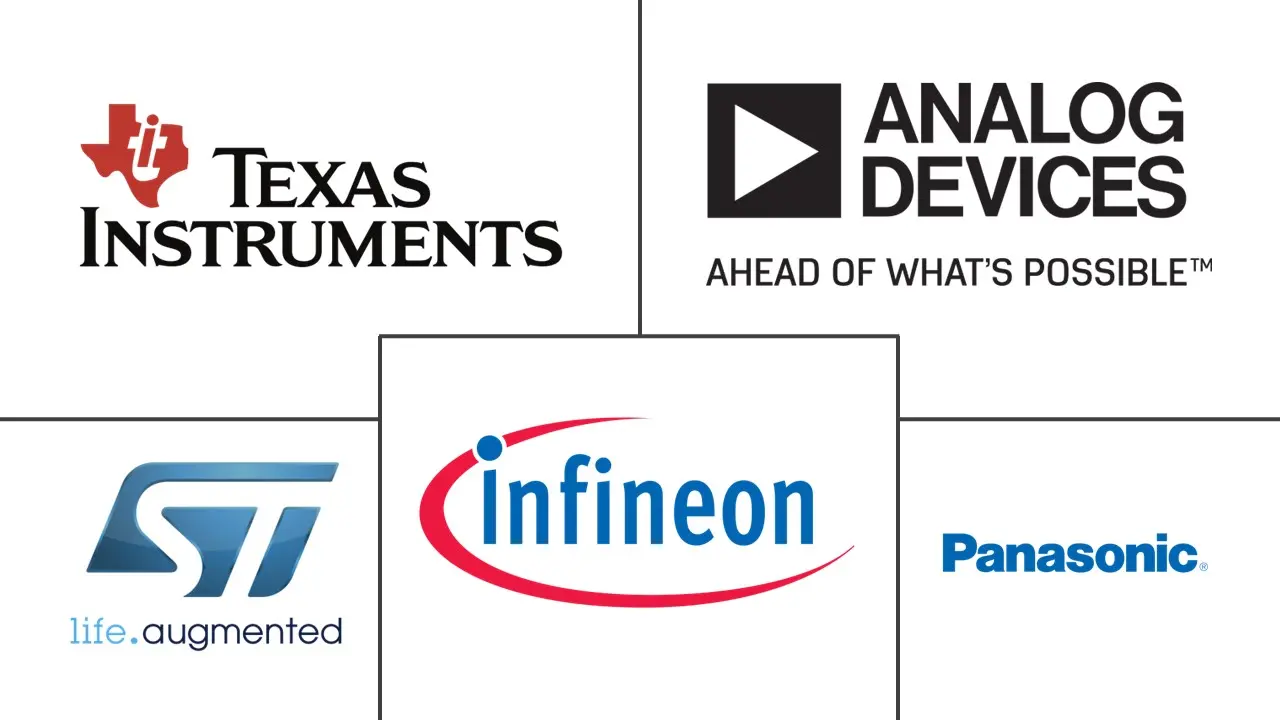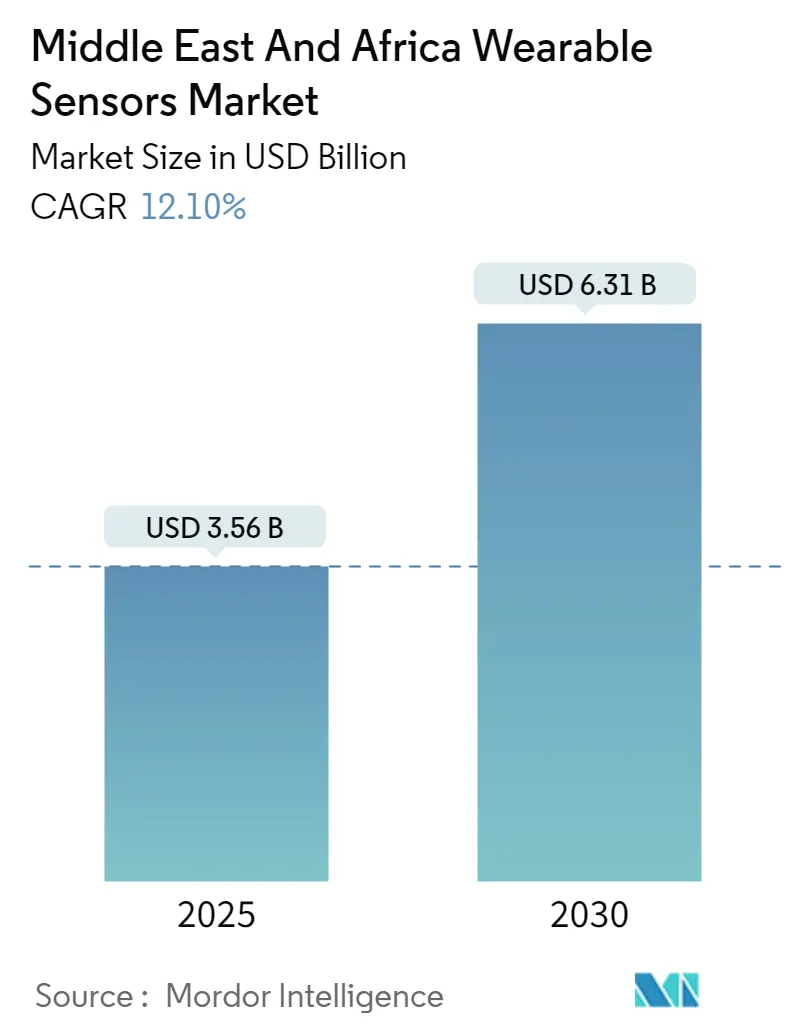
Middle East And Africa Wearable Sensors Market Analysis by Mordor Intelligence
The Middle East And Africa Wearable Sensors Market size is estimated at USD 3.56 billion in 2025, and is expected to reach USD 6.31 billion by 2030, at a CAGR of 12.1% during the forecast period (2025-2030).
Wearable sensors are gaining popularity in digital systems like health monitoring systems due to ongoing developments in modern technologies and miniature circuits. Wearable technology generally includes sensors and wireless connections, allowing users to monitor, track, and analyze data. Various accessories, including wristbands, eyeglasses, headphones, and smartphones, are combined with these wearable sensor systems.
- Increased spending on consumer electronics, improved lifestyles, and a surge in urbanization have led to a rise in health and safety awareness. With rising disposable incomes, devices like smart wristbands, smartwatches, fitness trackers, VR headsets, activity trackers, sports watches, healthcare applications, and enterprise and industrial applications are gaining tremendous traction. In June 2023, the Uniccon Group launched a highly anticipated VR headset at the GITEX Africa 2023.
- According to the Saudi Arabian Monetary Agency, consumer spending in Saudi Arabia increased to SAR 343,374 million (USD 91.554 billion) in the first quarter of 2022 from SAR 333,555 million (USD 88.936 billion) in the fourth quarter of the previous year. Furthermore, according to the OECD, Israel's economy grew by 4.9% in 2022 and 4% in 2023.
- One significant factor anticipated to drive the wearable sensors market during the forecast period is the growing elderly population. Over the coming decades, Saudi Arabia's aging population will rapidly grow.
- According to UN projections, the senior population in Saudi Arabia will rise from 5.6% in 2017 to 22.9% by 2050. Furthermore, according to the UN Population Fund, Egypt is undergoing a demographic transition as the number of people over 60 is predicted to more than double from 8.4 million (8% of the overall population) to 22 million between 2020-2050 (14%).
- The market is currently flooded with smart, Internet-connected products, and the number is expanding quickly. The primary condition for enabling adequate sensor data and information exchange is standardization. A few businesses have developed standards for sensor communication.
- The OGC's Sensor Web Enablement (SWE) measures satisfy the need for improved sensor connectivity in highly complicated and basic applications. Thousands of geospatial applications that use the OGC or other standards may easily incorporate this data due to the SWE standards. Interoperability problems are also brought on by the absence of universal standards for sensor communication.
- With the growing propensity of consumers toward smart wearables, the prices of instruments are also soaring, along with the increasing cost of components, thereby limiting adoption in the market. Smartwatches and fitness trackers have low-cost components that drive significant attention from consumers. However, with the increase of technology, other devices such as footwear, eyewear, and body wear products are highly priced and have lower adoption rates. Most wearable technologies are currently highly priced, negatively impacting adoption in the market.
- The ongoing conflict between Russia and Ukraine will significantly impact the electronics industry. The competition has already exacerbated the semiconductor supply chain issues and the chip shortage that have affected the industry for some time. The disruption may come in the form of volatile pricing for critical raw materials such as nickel, palladium, copper, titanium, aluminum, and iron ore, resulting in material shortages. This would obstruct the manufacturing of wearable sensors.
Middle East And Africa Wearable Sensors Market Trends and Insights
The Healthcare Sector is Expected to Register Significant Growth
- Wearable sensors are widely used in the healthcare sector. They are arranged on a patient's body and can be utilized to closely monitor patients' physiological condition. Wearable medical sensors monitor the patient's vital body signs (for example, temperature, heart rate, blood pressure, and oxygen saturation). The emergence of various sensors in healthcare applications is gaining momentum through the increasing array of wearable vital sign sensors and place tags, which can continuously track healthcare personnel and patient status/ location in real time.
- In October 2023, Huawei entered a new era of stylish, health-focused, and sport-ready wearables by introducing a new line-up of smartwatches, freebuds, smart glasses, and MatePad in the UAE. The range of new devices, including the Huawei Watch GT 4, the new addition to the popular smartwatch series, the high-end Huawei Watch Ultimate Design, Huawei Freebuds Pro 3 high-fidelity TWS earbuds, Huawei Eyewear 2 smart glasses, and the Huawei MatePad 11-inch PaperMatte Edition and MatePad 11.5-inch PaperMatte Edition that offer a paper-like reading and writing with 97% light interference reduction.
- According to a survey published by AppDynamics in 2022 (a study of more than 12,000 consumers worldwide), most people in the UAE bought more wearable health technology or applications in the following 12 months. The survey found that 88% of respondents in the Gulf country intended to use medical wearables, like Fitbit or smartwatches, in 2023. Further, around 90% of respondents in the UAE wanted access to heart rate, blood pressure, heart rhythms, physical activity, and respiratory rate from a watch or other wearable gadget. The UAE respondents said they believed wearable technology could transform both personal and public health.
- The market is witnessing collaborations as companies partner to develop innovative integrated solutions by leveraging each other's capabilities. In November 2023, LifeQ, a company using globally recognized watch brands to generate personalized, clinical-grade health insights, partnered with AAIC Investment. LifeQ co-founder Laurence (Laurie) Olivier, CEO, made the announcement. AAIC Investment focuses on fast-growing companies in Africa's healthcare sector and is deeply committed to improving healthcare in Africa.
- To cater to the upsurge in demand for healthcare wearable sensors, in March 2022, BioIntelliSense, Inc., a continuous health monitoring and clinical intelligence company, announced its strategic collaboration with Mubadala Health, an integrated healthcare network of Mubadala Investment Company. The partnership incorporates BioIntelliSense's innovative remote care technologies with Mubadala Health's continuous care model to drive clinical workflow efficiencies, unlock data-driven clinical insights, and deliver a personalized care experience.
- Increasing health concerns like heart ailments, diabetes, cancer, and respiratory diseases in the region are likely to drive the population toward adopting wearable sensors. For instance, according to the Ministry of Health, Saudi Arabia, 24.3% of the adult population in Saudi Arabia is expected to have diabetes by 2026. Such factors are expected to boost the market's growth.
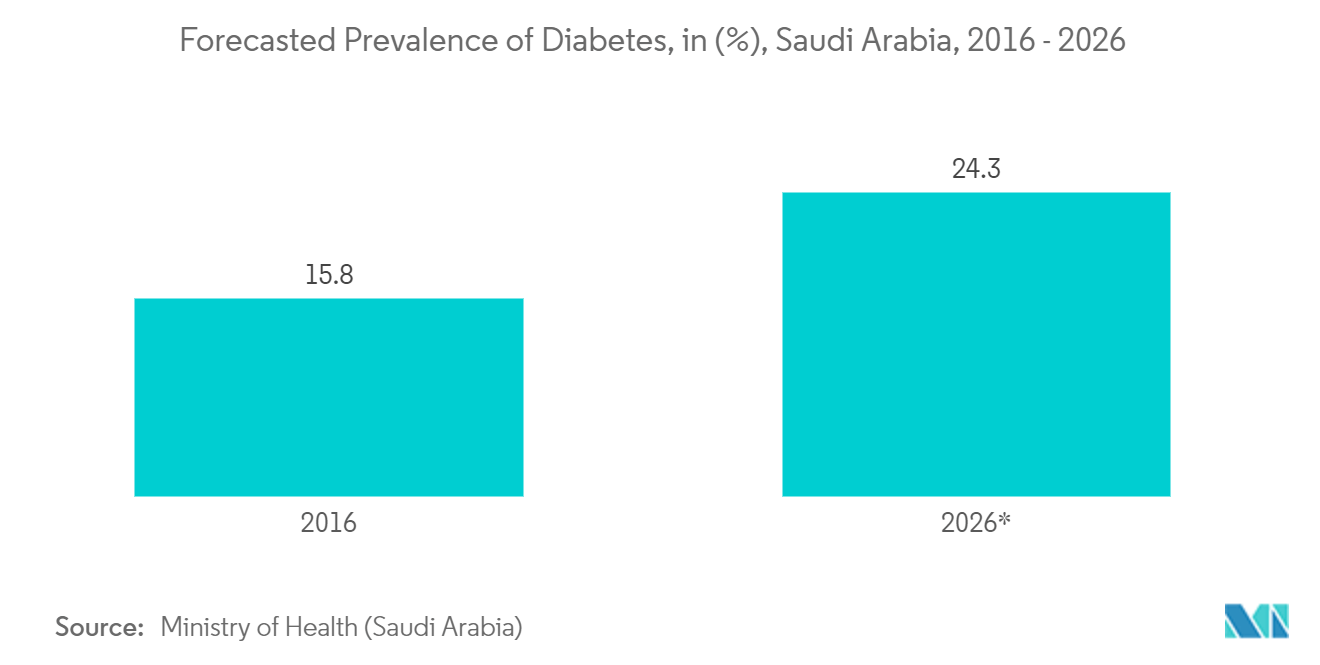
Saudi Arabia Holds a Significant Market Share
- Wearable Sensors are experiencing significant growth in Saudi Arabia. Wearable technology has become increasingly integrated into daily life and various industries nationwide, utilized for fitness tracking, healthcare monitoring, and industrial applications. According to the WHO, in 2022, Saudi Arabia's expenditure on healthcare totaled USD 60.7 billion. According to the report, the healthcare expenditure of Saudi Arabia in 2027 is expected to reach USD 77.1 billion.
- A dedicated focus on getting in shape, building the body's immunity, and managing stress drives the surge in the popularity of wearables in the fitness category. Smartwatches play a vital role by becoming extensions of the user's body and a smartphone accessory. These devices can be worn all day and work as the user's smart assistant to aid them in actively managing their health while exploring immersive application experiences.
- In March 2022, Huawei and SFA (Saudi Sports for All Federation) joined forces to promote advanced wearable devices designed specifically for runners. The SFA organized a marathon event to promote well-being and increase physical activity levels across the population in line with the Saudi Vision 2030 objectives.
- As a result, more than 10,000 runners participated in the inaugural marathon. Huawei gifted all marathon participants with a 200 SAR voucher to buy anything from the official Huawei website, such as the stunning HUAWEI WATCH GT Series, including the company's first professional running watch, the HUAWEI WATCH GT Runner, which has a wide range of health and well-being monitoring features as well as dozens of sport modes to help users level up their fitness. Such initiatives spread awareness about the latest wearable sensors to monitor health and fitness, thereby driving the growth of the market.
- The country's increasing number of smartphone users is expected to offer lucrative market growth opportunities as they enable wearable device integration. According to Eurostat, the number of internet users in Saudi Arabia in January 2023 was 36.3 million users, up from 35.8 million users in the previous year.
- Cancer patients are undergoing chemotherapy and radiotherapy as therapeutic treatments for their cancer conditions. Demand for wearable medical sensors is also increasing due to the rapidly growing population concerned about health conditions. According to the World Bank, the country's population may reach 45.1 million by 2050, with a 1.02% average annual growth. This increase in population is anticipated to boost the demand for healthcare services in the country.
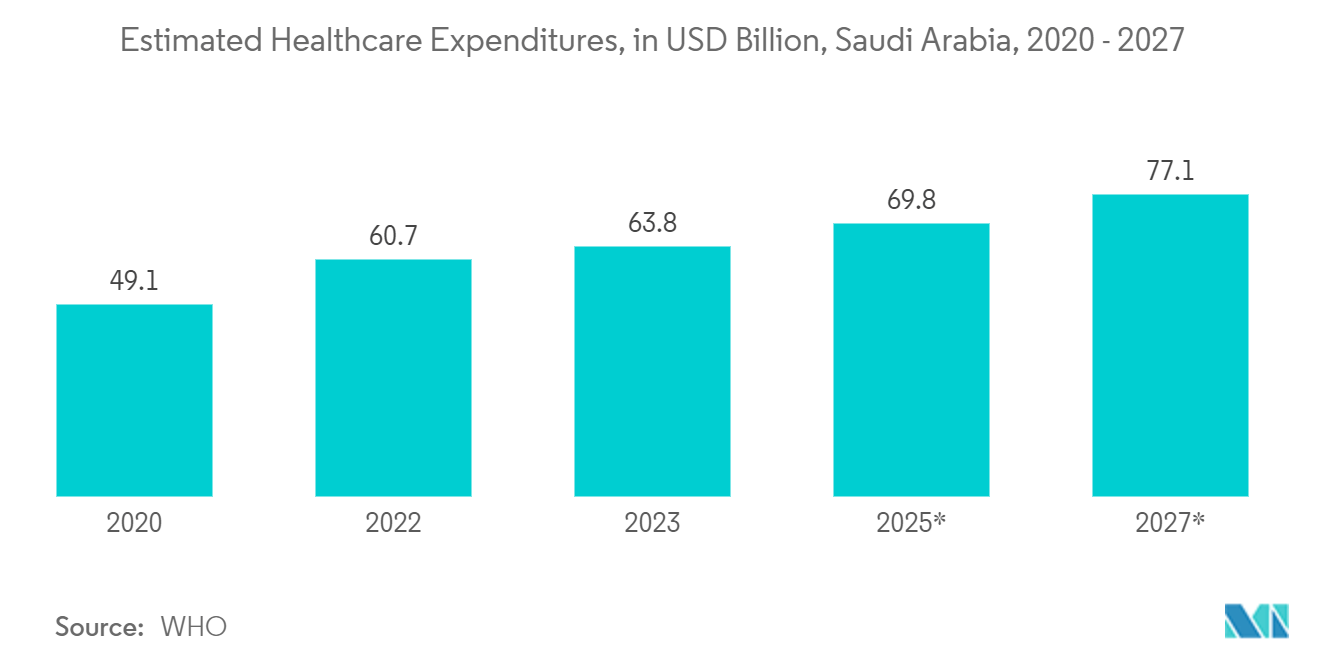
Competitive Landscape
The Middle East and African wearable sensor market is semi-consolidated, with the presence of a few significant companies like STMicroelectronics, Infineon Technologies AG, Texas Instruments Incorporated, and Analog Devices. The companies continuously invest in strategic collaborations and product developments to gain market share.
- November 2023: The upcoming Redmi K70 series, a Xiaomi Smartwatch, surfaced on the UAE's TDRA certification. Bearing the model code M2320W1, the smartwatch was registered as a short-range smartwatch device. Xiaomi's subbrand Redmi plans to launch the Redmi K70 Series, which consists of the Redmi K70e, Redmi K70, and Redmi K70 Pro. The Redmi K70e will come with a 6.67-inch OLED display with a 120Hz refresh rate and a resolution of 2712 x 1220 pixels.
- October 2023: Google launched its Pixel Watch 2 smartwatch, featuring advanced health-related characteristics such as heart rate tracking and sleep tracking. The device uses a photoplethysmography (PPG) sensor that measures blood circulation by shining a green LED light onto the user's wrist. The watch also includes improved AI-powered algorithms to provide more accurate heart rate data.
Middle East And Africa Wearable Sensors Industry Leaders
-
STMicroelectronics
-
Infineon Technologies AG
-
Texas Instruments Incorporated
-
Analog Devices
-
Panasonic Corporation
- *Disclaimer: Major Players sorted in no particular order
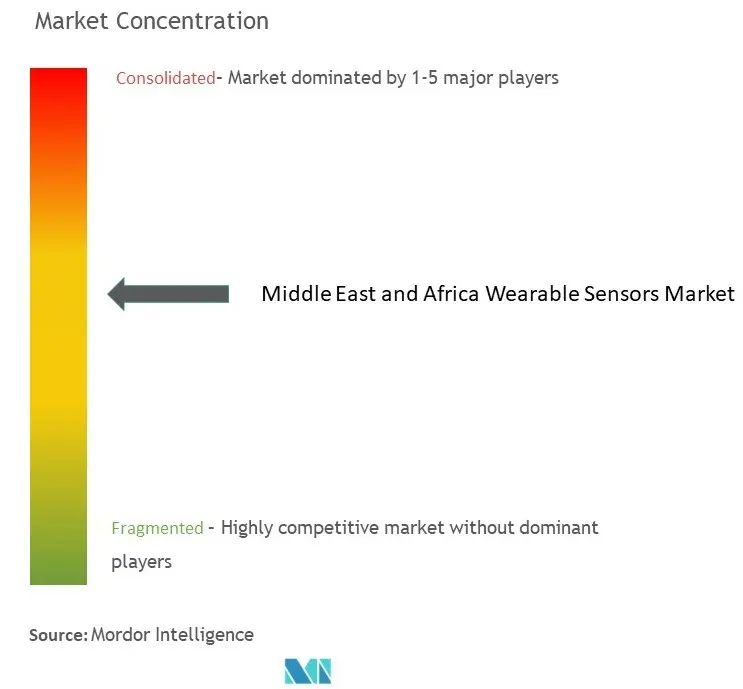
Recent Industry Developments
- February 2024 - ams OSRAM, a frontrunner in sensor and semiconductor technology, announced partnership with greenteg . This partnership enhances consumer health-wearable technology by integrating a new health matrix specifically for tracking core body temperature.
- January 2024 - Texas Instruments Inc. upgraded its digital temperature sensor portfolio with TMP119, which can be widely utilized in the wearable fitness and activity monitor application along with other applications.
Middle East And Africa Wearable Sensors Market Report Scope
Wearable sensors monitor health and supply clinically important data for treatment. They can be integrated into wearable devices or used directly on the body. Owing to the development of sensor technologies, wearables now have a greater capacity for measurement. As a result, customers better understand themselves and are better equipped to alter their lifestyles.
The Middle East and African wearable sensors market is segmented by type (temperature, pressure, image/optical, motion, and other types of sensors), application (health and wellness, safety monitoring, sports and fitness, and other applications), and country (United Arab Emirates, Saudi Arabia and the Rest of Middle East and Africa). The market sizes and forecasts are provided in terms of value (USD) for all the above segments.
| Temperature |
| Pressure |
| Image/Optical |
| Motion |
| Other Types of Sensors |
| Health and Wellness |
| Safety Monitoring |
| Sports and Fitness |
| Other Applications |
| United Arab Emirates |
| Saudi Arabia |
| By Type | Temperature |
| Pressure | |
| Image/Optical | |
| Motion | |
| Other Types of Sensors | |
| By Application | Health and Wellness |
| Safety Monitoring | |
| Sports and Fitness | |
| Other Applications | |
| By Country | United Arab Emirates |
| Saudi Arabia |
Key Questions Answered in the Report
How big is the Middle East And Africa Wearable Sensors Market?
The Middle East And Africa Wearable Sensors Market size is expected to reach USD 3.56 billion in 2025 and grow at a CAGR of 12.10% to reach USD 6.31 billion by 2030.
What is the current Middle East And Africa Wearable Sensors Market size?
In 2025, the Middle East And Africa Wearable Sensors Market size is expected to reach USD 3.56 billion.
Who are the key players in Middle East And Africa Wearable Sensors Market?
STMicroelectronics, Infineon Technologies AG, Texas Instruments Incorporated, Analog Devices and Panasonic Corporation are the major companies operating in the Middle East And Africa Wearable Sensors Market.
What years does this Middle East And Africa Wearable Sensors Market cover, and what was the market size in 2024?
In 2024, the Middle East And Africa Wearable Sensors Market size was estimated at USD 3.13 billion. The report covers the Middle East And Africa Wearable Sensors Market historical market size for years: 2019, 2020, 2021, 2022, 2023 and 2024. The report also forecasts the Middle East And Africa Wearable Sensors Market size for years: 2025, 2026, 2027, 2028, 2029 and 2030.
Page last updated on:
Middle East And Africa Wearable Sensors Market Report
Statistics for the 2025 Middle East And Africa Wearable Sensors market share, size and revenue growth rate, created by Mordor Intelligence™ Industry Reports. Middle East And Africa Wearable Sensors analysis includes a market forecast outlook for 2025 to 2030 and historical overview. Get a sample of this industry analysis as a free report PDF download.
